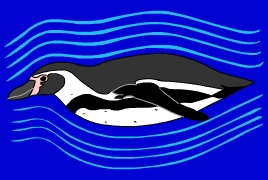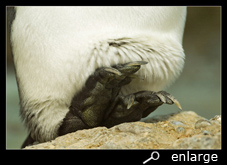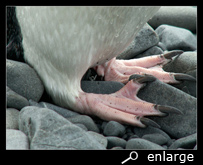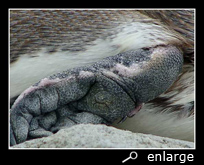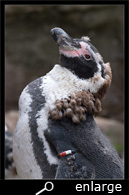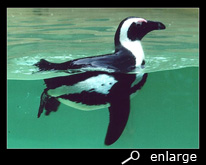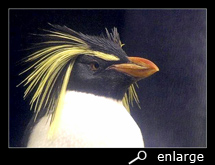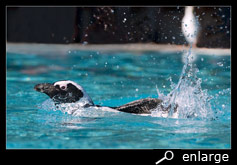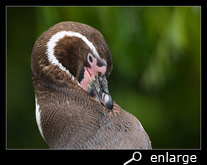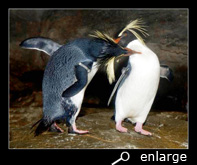
- Size
- Shape
- Flippers
- Feet
- Feathers
- Body care
Size
The largest, still living species is the emperor penguin, measuring 120 cm and the smallest is the fairy penguin, only 30 cm tall.
Also is known that there is a small difference in size and weight between the sexes, where the females are the "weaker"
(smaller and a bit lighter) sex.
It's only logical that these are always average sizes. Depending on the living conditions and the period of measuring (before or after moulting and breeding), these sizes can vary pro species. Moreover will measuring 100 birds probably give other results as when you would measure 1000 birds.
It's only logical that these are always average sizes. Depending on the living conditions and the period of measuring (before or after moulting and breeding), these sizes can vary pro species. Moreover will measuring 100 birds probably give other results as when you would measure 1000 birds.
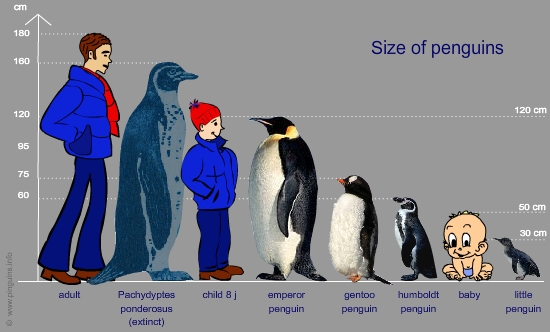
Shape
Their body shape is perfectly adapted to a live in the water.
Through their streamlined form, they can move fast through the water, without much resistance. For a penguin the resistance of the water
is only one third of those for a sub-marine.
Their body is not equable broad over the whole length, but more "wave-like". After a small bill, the head is broad, followed by a thinner neck and ending with a thick body.
This shape, among with the feathers, results in the fact that the water-flow clings close to the body and no interfering and restraining whirls can be formed. In that way a penguin can achieve a high swimming speed.
Their body is not equable broad over the whole length, but more "wave-like". After a small bill, the head is broad, followed by a thinner neck and ending with a thick body.
This shape, among with the feathers, results in the fact that the water-flow clings close to the body and no interfering and restraining whirls can be formed. In that way a penguin can achieve a high swimming speed.
Flippers
Although the structure of a penguin flipper is very likely as for wings of flying birds,
the bones are massive, short and flattened.
This results in a stiff paddle, with less mobility in the elbow.
The upper side of the flippers is covered with very short, stiff feathers, mistaken by earlier scientists for scales. In opposition to the feathers on the rest of their body, those on the flippers aren't waterproof, while then the flipper would be too thick.
Because a flipper has only a small blood supply, it doesn't need thermal insulation.
Besides, the flippers and legs are the only parts where a penguin can lose heat surplus. (see thermal insulation).
The propulsion of flippers and also the most distinguishing mark of bird anatomy is the strong breast musculature. The large breast muscle (pectoralis major) on the outside, pulls the wing downwards, while the smaller one, the Supracoracoideus, pulls the flipper upwards again. Advantage of this, in opposite with large shoulder muscles, is the fact that the most of the muscle mass, and therefore the centre of gravity of a penguin, lays low in the body, increasing the stability under water during swimming.
 To prevent the body for collapsing and organs becoming hurt, by contraction of the breast muscles, the chest is strengthened
with processes and rigid.
To prevent the body for collapsing and organs becoming hurt, by contraction of the breast muscles, the chest is strengthened
with processes and rigid.
By flying birds especially the pectoralis major has to do the most labour. It pulls the wing down and delivers the lifting-power and propulsion during flight. The upwards force is mostly reached passive through air current. For a penguin the wing-beat in the water is similar to those by flying birds. But they also use muscular strength for upwards motion, to increase their speed in the water. Therefore the smaller muscle, the supracoracoideus, is also very good developed. So they are capable to speed up fast and a fish has little change to escape.
The upper side of the flippers is covered with very short, stiff feathers, mistaken by earlier scientists for scales. In opposition to the feathers on the rest of their body, those on the flippers aren't waterproof, while then the flipper would be too thick.
Because a flipper has only a small blood supply, it doesn't need thermal insulation.
Besides, the flippers and legs are the only parts where a penguin can lose heat surplus. (see thermal insulation).
The propulsion of flippers and also the most distinguishing mark of bird anatomy is the strong breast musculature. The large breast muscle (pectoralis major) on the outside, pulls the wing downwards, while the smaller one, the Supracoracoideus, pulls the flipper upwards again. Advantage of this, in opposite with large shoulder muscles, is the fact that the most of the muscle mass, and therefore the centre of gravity of a penguin, lays low in the body, increasing the stability under water during swimming.

By flying birds especially the pectoralis major has to do the most labour. It pulls the wing down and delivers the lifting-power and propulsion during flight. The upwards force is mostly reached passive through air current. For a penguin the wing-beat in the water is similar to those by flying birds. But they also use muscular strength for upwards motion, to increase their speed in the water. Therefore the smaller muscle, the supracoracoideus, is also very good developed. So they are capable to speed up fast and a fish has little change to escape.
Feet and legs
A penguin has very short legs. And he really has knees and upper-legs, but while covered with feathers this is not visible.
Research showed that waddling, although comical to see, has good reasons. The birds would waste far more energy if they did not waddle.
Logically they have webbed feet, as an adaptation to their life in the water.
Research showed that waddling, although comical to see, has good reasons. The birds would waste far more energy if they did not waddle.
Logically they have webbed feet, as an adaptation to their life in the water.
Feathers
Every cm² penguin skin is covered with 12 feathers. The feathers are 3 cm long, slightly bent and become regular cleaned and oiled.
Directly on the skin you find downy feathers, imbricately placed, forming the so called "thermo-underwear".
They're there to keep the body warm. (see thermal insulation)
Above them lay the oiled upper feathers, forming a waterproof "wetsuit".
The wing-coverts have no downy undercoat and are very stiff. They are used for propulsion during swimming.(see flippers).
Although they say penguins are black and white, this is not completely true. Often their back has a blue shining, instead of black. Each feather has a more or less blue spot at the end. Especially at little and king penguins this blue shine is very striking.
But that blue shine, very clear direct after moulting, will become more matt grey or brown during the year. And the white of their bellies will turn to filthy yellow.
In opposite to our hair, feathers only grow for a short while and then remain unchanged. While they need to protect a penguin against cold, water and sharp cliffs, they wear a lot.
Therefore a penguin has to renew his feathers every year after breeding: called moulting. They have to stuff a lot of food, while during moult they can't go to sea for food. During the moulting period (about three weeks), their feathers aren't waterproof so they would freeze and drown. Besides they wouldn't be fast enough too to catch their food. During that period, the old feathers are pushed out by the underneath growing new ones and fall out. The penguins look depressing and when they finally have their new feathercoat, this seems too large because they lost so much weight (till a third of their entire body weight) during the three weeks lasting moulting period.
The colour too, of the several species has its reason: for most birds it serves as camouflage or to recognize congeners and as communication (as for peacocks).
For a penguin too, communication in the water is important. But only his head and back is above the water surface, so a coloured body would make no sense. And indeed, the difference between the several species lays in the colour (and form) of the feathers on the head and on the throat. (see Characteristics).
The adelie, gentoo and chinstrap penguins sometimes breed in mixed colonies round Antarctica. They differ by respectively a band on the chin (chinstrap) or a white spot on the head and orange bill (gentoo). So penguins aren't always only black and white.
And all crested penguins differ by the form and color of their crest.
Under water penguins all look the same: white front and a black coat. This also has its reason: it serves as camouflage. When they swim or dive, the upperside is dark und the underside light. Predators on the water surface, like sea leopards, can hardly recognize them against the dark background of the sea. And from below, they look light against the bright surface of the water and so hardly visible too.
This principal is especially used when hunting. African penguins approach a swarm fish from below (very inconspicuous) and then, unexpected, let brighten up their white fronts. The swarm fish, being startled, breaks apart, so the penguins can easier catch a single fish. (see food).
Above them lay the oiled upper feathers, forming a waterproof "wetsuit".
The wing-coverts have no downy undercoat and are very stiff. They are used for propulsion during swimming.(see flippers).
Although they say penguins are black and white, this is not completely true. Often their back has a blue shining, instead of black. Each feather has a more or less blue spot at the end. Especially at little and king penguins this blue shine is very striking.
But that blue shine, very clear direct after moulting, will become more matt grey or brown during the year. And the white of their bellies will turn to filthy yellow.
In opposite to our hair, feathers only grow for a short while and then remain unchanged. While they need to protect a penguin against cold, water and sharp cliffs, they wear a lot.
Therefore a penguin has to renew his feathers every year after breeding: called moulting. They have to stuff a lot of food, while during moult they can't go to sea for food. During the moulting period (about three weeks), their feathers aren't waterproof so they would freeze and drown. Besides they wouldn't be fast enough too to catch their food. During that period, the old feathers are pushed out by the underneath growing new ones and fall out. The penguins look depressing and when they finally have their new feathercoat, this seems too large because they lost so much weight (till a third of their entire body weight) during the three weeks lasting moulting period.
The colour too, of the several species has its reason: for most birds it serves as camouflage or to recognize congeners and as communication (as for peacocks).
For a penguin too, communication in the water is important. But only his head and back is above the water surface, so a coloured body would make no sense. And indeed, the difference between the several species lays in the colour (and form) of the feathers on the head and on the throat. (see Characteristics).
The adelie, gentoo and chinstrap penguins sometimes breed in mixed colonies round Antarctica. They differ by respectively a band on the chin (chinstrap) or a white spot on the head and orange bill (gentoo). So penguins aren't always only black and white.
And all crested penguins differ by the form and color of their crest.
Under water penguins all look the same: white front and a black coat. This also has its reason: it serves as camouflage. When they swim or dive, the upperside is dark und the underside light. Predators on the water surface, like sea leopards, can hardly recognize them against the dark background of the sea. And from below, they look light against the bright surface of the water and so hardly visible too.
This principal is especially used when hunting. African penguins approach a swarm fish from below (very inconspicuous) and then, unexpected, let brighten up their white fronts. The swarm fish, being startled, breaks apart, so the penguins can easier catch a single fish. (see food).
Preening
Preening is for a penguin very important, even more it is life-saving.
By oiling their feathers with a mix from the preen gland (see also : thermal insulation), they make their feathers waterproof. Only so they are protected against the water and cold.
In the colony, a penguin (and not only he, but also people who come too close) can become very dirty, because no-one mind where the excrements land they are pushing out. And when making their nest (like the banded or Spheniscus penguins), earth is flying everywhere. Morning bath is mostly taking place on the shore, but when they think a predator is in the neighbourhood, they swim away on the open sea to take their bath.
Thermal insulation is managed by their feathers and the fat under the skin. The feathers (see body) lay close together and are often oiled, to make a waterproof "wetsuit".
As soon as penguins are out of the water, they start cleaning and combing their feathers. With their bill they go with uniform motions through their feathers and shuffle their head to remove the water. Their neck is so mobile they can reach almost every single place. After each motion they bring their bill to the preen gland, an double-sac organ as large as a pea, located on the back near the base of the tail, in which a waxy oil is found.
The secretions of the preen gland empty to the skin surface through one or more nipplelike pores. Most birds preen by rubbing their bill and head over the preen gland pore and then rubbing the accumulated oil over the feathers of the body and wings and the skin of the legs and feet.
This oil, a complex mix of oil and wax, prevents dehydration and acts especially as insulation against the water. It also is a "dirt-antidote" and prevents mildews, bacteria or algae to clutch at the feathers.
This oil reduces the friction of the water to a minimum, so a penguin seems to "fly" through the water. As soon as dirt or e.g. oil from an oilspill pollute their feathers, this friction resistant increases and the bird slows down, causing a lot of problems or even mean dead.
Preening can even be a part of the breeding behaviour. Among couples, it is a sign of love when they clean each others feathers on that parts which the other hardly can reach.
By oiling their feathers with a mix from the preen gland (see also : thermal insulation), they make their feathers waterproof. Only so they are protected against the water and cold.
In the colony, a penguin (and not only he, but also people who come too close) can become very dirty, because no-one mind where the excrements land they are pushing out. And when making their nest (like the banded or Spheniscus penguins), earth is flying everywhere. Morning bath is mostly taking place on the shore, but when they think a predator is in the neighbourhood, they swim away on the open sea to take their bath.
Thermal insulation is managed by their feathers and the fat under the skin. The feathers (see body) lay close together and are often oiled, to make a waterproof "wetsuit".
As soon as penguins are out of the water, they start cleaning and combing their feathers. With their bill they go with uniform motions through their feathers and shuffle their head to remove the water. Their neck is so mobile they can reach almost every single place. After each motion they bring their bill to the preen gland, an double-sac organ as large as a pea, located on the back near the base of the tail, in which a waxy oil is found.
The secretions of the preen gland empty to the skin surface through one or more nipplelike pores. Most birds preen by rubbing their bill and head over the preen gland pore and then rubbing the accumulated oil over the feathers of the body and wings and the skin of the legs and feet.
This oil, a complex mix of oil and wax, prevents dehydration and acts especially as insulation against the water. It also is a "dirt-antidote" and prevents mildews, bacteria or algae to clutch at the feathers.
This oil reduces the friction of the water to a minimum, so a penguin seems to "fly" through the water. As soon as dirt or e.g. oil from an oilspill pollute their feathers, this friction resistant increases and the bird slows down, causing a lot of problems or even mean dead.
Preening can even be a part of the breeding behaviour. Among couples, it is a sign of love when they clean each others feathers on that parts which the other hardly can reach.
© Pinguins info | 2000-2021
